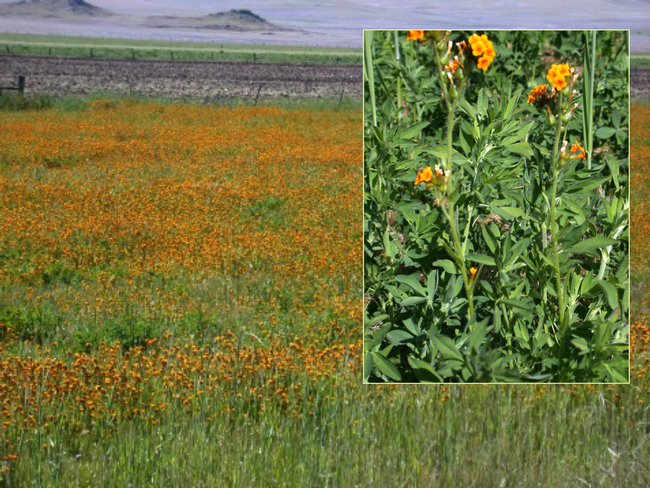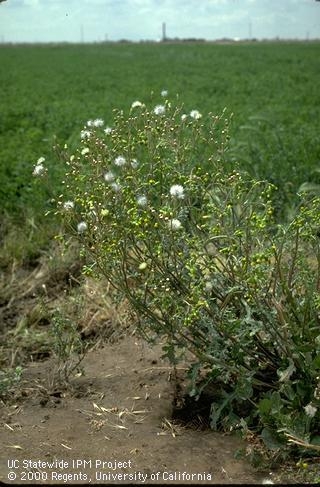Fiddleneck is everywhere this year, and common groundsel is common too! As winter annuals, these weeds are early-season plants. They tend to be shallow rooted, and do best in wet conditions like we've been having with all our rainfall this season.
Colorful but Deadly. Fiddleneck (Amsinckia spp.) may look bright and colorful on our hillsides, but this weed, as well as groundsel (Senecio vulgaris), are toxic to livestock, because they contain toxins known as pyrrolizidine alkaloids (PAs) that affect the liver. Cattle and horses are most sensitive to PAs; pigs and chickens are less sensitive, and sheep, goats and turkeys are the least sensitive. Younger animals are more susceptible than adults.
PA poisoning is a chronic condition subsequent to cumulative exposure. Typically, animals are exposed to low doses over a period of weeks to months before they develop toxic symptoms. Exposure to high doses of PAs within a period of a few days is rarely seen in animal symptoms. There is no effective treatment for PA toxicosis.
What Part is Toxic? The entire plant is toxic at all growth stages for both of these weeds. The plant parts ranked in decreasing concentration (highest to lowest) in PAs are: flowers and seeds > leaves > stems > roots. PAs are heat and desiccant resistant and thus maintain their toxicity in dried plant material and hay. Livestock will selectively graze and avoid groundsel and fiddleneck in pastures, as long as pastures are not overgrazed. However, livestock cannot effectively sort the good from the bad plants when dried because these weeds may reduce their bitterness, but not their toxicity after drying.
Since PA poisoning is cumulative, and levels of toxin in feeds vary, livestock that eat fiddleneck and groundsel for an extended period of time are at risk for developing illness. Affected animals lose condition, have decreased production, and may develop icterus (jaundice) and photosensitization because of the toxic effects to the liver.
Herbicides. There are a number of herbicides that effectively control fiddleneck and groundsel in forage crops when applied in December/January timing (see http://ipm.ucanr.edu/PMG/selectnewpest.alfalfa-hay.html for more information). However, as in past very wet years, we have seen reduced groundsel control with Velpar when rains push the herbicide below germinating seedlings. Once the plants are large and flowering, there isn't anything one can spray that will totally eliminate these weeds in forage crop fields. Burning the leaves and stems with an herbicide to a point where they begin to desiccate would reduce the amount of weed biomass, but toxicity will not be eliminated.
The best way to prevent problems is to avoid feeding PA-contaminated feed to horses and cattle. Before cutting and baling your hay, inspect the field to identify any potential toxic plants, particularly along field borders. PA containing weeds should never be offered to cattle and horses.
